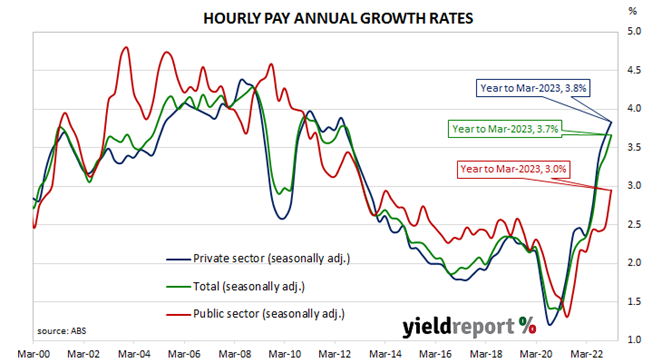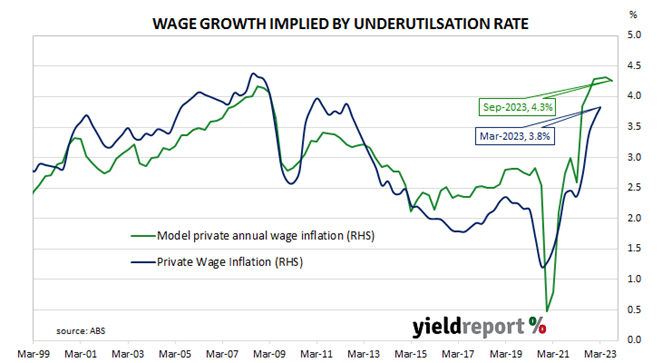Summary: March quarter wages up 0.8%, below expectations; annual growth rate increases from 3.4% to 3.7%; Westpac: a step down in quarterly pace of wage inflation; ANZ: annual result alone likely not enough for RBA to read result as hawkish surprise; private sector wages up 3.8% over year, public sector up 3.0%; March underutilisation rate implies faster wage growth in short-term.
After unemployment increased and wage growth slowed during the GFC, a resources investment boom prompted a temporary recovery back to nearly 4% per annum. However, from mid-2013 through to the September quarter of 2016, the pace of wage increases slowed, until mid-2017 when it began to slowly creep upwards. After remaining fairly stable at around 2.2% per annum from September 2018 to March 2020, the growth rate slowed significantly in the June and September quarters of 2020 before speeding up in 2021 and 2022.
According to the latest Wage Price Index (WPI) figures published by the Australian Bureau of Statistics (ABS), hourly wages grew by 0.8% in the March quarter. The result was below expectations of a 0.9% rise but in line with the December quarter’s rise. On an annual basis, the growth rate accelerated from 3.4% after revisions to 3.7%.
“The March quarter confirms that we have now seen a step down in the quarterly pace of wage inflation with the 1.1% increase last September now appearing to have been the peak,” said Westpac senior economist Justin Smirk.
Domestic Treasury bond yields increased modestly on the day. By the close of business, the 3-year ACGB yield had gained 3bps to 3.12% while 10-year and 20-year yields both finished 2bps higher at 3.43% and 3.89% respectively.
In the cash futures market, expectations regarding rate cuts in 2024 softened slightly. At the end of the day, contracts implied the cash rate would remain essentially steady in the short-term to average 3.845% in June and 3.89% in July. February 2024 contracts implied a 3.715% average cash rate while May 2024 contracts implied 3.53%, 29bps less than the current rate.
“The higher annual result alone is likely not enough for the RBA to read this result as a hawkish surprise, given that quarterly wage growth did not accelerate,” observed ANZ senior economist Adelaide Timbrell. “Though some details within the data might provide a signal for more acceleration to come.”
Wages in the private and public sectors grew by 0.8% and 0.9% respectively in the quarter. Over the past 12 months, wages in the private sector increased by 3.8% while public sector wages increased by 3.0%. Annual wage growth in the two sectors had been at 3.6% and 2.5% respectively in the December quarter.
The “underutilisation rate” is simply the sum of the unemployment and underemployment rates as per ABS monthly statistics. It has a good correlation with private wage growth two quarters in the future and thus it is useful as a leading indicator. However, differences can open up from time to time. March’s underutilisation rate suggests private wage growth is likely to continue accelerating in the short-term.
Each quarter the ABS surveys around 3,000 private and public enterprises regarding a sample of jobs in each workplace to measure changes in the price of labour across 18,000 jobs. The results are used to construct the Wage Price Index in a manner similar to the construction of the Consumer Price Index (CPI). Changes in the WPI over time provide a measure of changes in wages and salaries, independently of the type or quantity of work.



